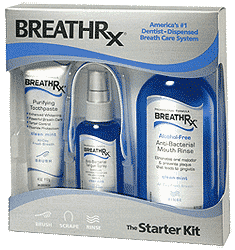Halitosis (Bad Breath)Halitosis may be caused by many factors, the most common of which are dietary predilections and inadequate oral hygiene. If dietary adjustments do not resolve the issue, one should first consider a visit to the dentist, improved oral hygiene, and gastrointestinal or systemic disorders, such as diabetes. Poor oral hygiene, advanced tooth decay or periodontal disease may result in bad breath that may range from offensive to fetid. For many, bad breath is caused by the accumulation of bacteria lodging in the ridges of the tongue. Incorporating a small plastic rake (tongue scraper) into a regular oral hygiene program will prove a godsend to those who experience this problem. A germicide mouth rinse, containing chlorine dioxide, may be beneficial. CloSys is an excellent example of this type of mouth rinse. Poor dental hygiene may result in acute necrotizing ulcerative gingivitis (ANUG). Once called trench mouth, the condition is fairly uncommon in advanced countries, but may develop in teenagers and young adults. Though not contagious, it can, and should be treated. Perhaps the best gift you can give a loved one is a visit to the dentist. | BreathRx |
Discolored & Crooked TeethPerhaps no aspect of dental care has been so far advanced in the past decade as aesthetic dentistry. With the introduction of adhesive restoration treatment and conservative tooth reduction techniques, cosmetically appealing restorations are often routine and less invasive. Dental bleaching has become a popular and successful approach in the management of extrinsic stains on enamel. It does not affect previously placed restorations. Porcelain veneers have taken the place of bonding in most instances, and may offer a dynamic alternative to crowns (caps). The technique is often indicated for managing crooked or extensively discolored teeth, sometimes instead of adult orthodontics. Find out what modern aesthetic dentistry has to offer! | NiteWhite |



